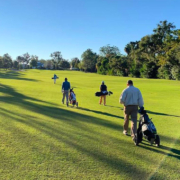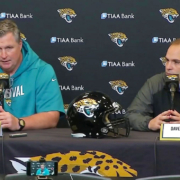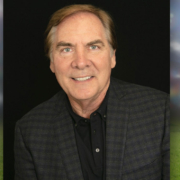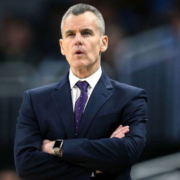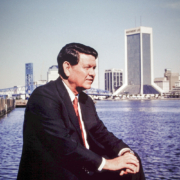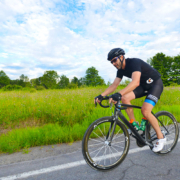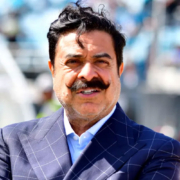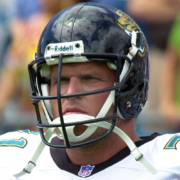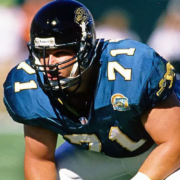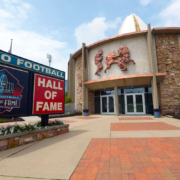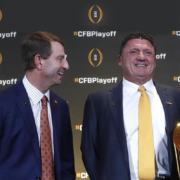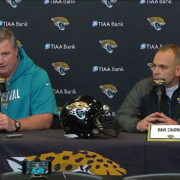Things We CAN Do
We’ve been told a lot over the past week what we can’t do. “Don’t do this” and “Don’t do that” have been among the myriad levels of “stay at home” mandates.
So what can we do?
Turns out, “stay at home” doesn’t mean sit in your living room eating Cheetos or cowering to the coronavirus. While this new reality, at least for the next month or so, has changed our routines, it doesn’t mean it has to completely change our lives.
National, state and local parks might be closed but thirty-eight of the forty-one boat ramps in Duval County are still open. Some kayaks and stand-up paddleboards are gathering dust in your garage. Don’t get into a pickup basketball game, but shooting hoops at the basket you haven’t used in your front yard is still allowed.
Playing golf, riding your bike, going to the shooting range, finding a creative way to work out and even just going for a walk are all still options.
“I’ve never seen so many people out running and walking,” Gate River Run Director Doug Alred said this week. Alred also owns the four First Place Sports running stores in town and says that with the guidelines to close his retail doors, he’ll keep his Baymeadows store open for call in orders. Nike has also given him permission to list some shoes online at Amazon.
“They can call in and we’ll sell them shoes, socks, whatever they need over the phone and give it to them in the parking lot,” he said. “A lot of people out don’t know of us because they’re not part of this lifestyle. We’re hopeful some people will stick with it and something healthy will come out of this crisis.”
Alred’s business is down like any other retail store but other than not needing his part time help, the full time staff has been staying busy sanitizing the store and doing other projects. Some of them were laid off Friday with Doug hoping they can qualify for unemployment insurance quickly.
“We’re constantly cleaning, our employees are wearing gloves but it’s hard to social distance when people are working behind the counter or helping customers try on shoes,” he said, adding that while at 71 years old he’s still running about ten miles a week, but keeping his distance.
Running might mainly be a solo sport and activity, but scheduled group runs and races are a part of that lifestyle. For now though, they’re out of the picture.
“If the Gate (River Run) was two days later, we’d have probably had to cancel it,” Alred said, relieved the race went off as planned.
“We’ve cancelled or postponed nineteen different runs through the first of May. Even the Run for the Pies the second week of June looks in peril. I’m hoping for the Fourth of July to start up again but I’m not sure how many people are going to want to get in a group run.”
Getting on your bike is another option. You know, that bike in your garage you haven’t ridden in years?
“Two weeks ago, people just started flooding the stores, coming in for repairs,” Phil Foreman co-owner of three Champion Cycling stores in town explained. “Rusted chains, flat tires, bikes they haven’t ridden in years.”
“I’ve had fourteen Fourth of July’s at the beach store,” Foreman’s business partner Brian Corcoran said.
Fourth of July is one of their biggest weeks of the year. Corcoran said every day for the past couple of weeks has been just like that.
“People are showing up with bikes they haven’t ridden in years. Rusty chains, flats, a whole new wave of weekend warriors. People who don’t ride their bike but four or five times a year are riding now every weekend.”
With all of that interest, “social distancing” can be a challenge but Foreman says they have a plan.
“We’ve been sanitizing the stores multiple times, during the day, especially places where the customer is touching: handles, credit card machines,” he explained.
“We’re bike mechanics so we’re always washing our hands. We wear gloves and some of our employees are wearing masks. I probably wash my hands fifty times a day,” Corcoran said.
“Sixty percent of our business now is repairs, but we’re still selling a lot of bikes,” Phil added.
“We’ve sold lots of bikes over the phone,” Corcoran echoed. “They’ll ask, ‘Can you bring it out in the parking lot?’ We’ll wipe the bikes down and bring them out. I’ve sold a bunch of bikes like that to grandparents who are getting bikes for their grandkids. I’m seeing a lot of new customers.”
Phil and Brian are doing a lot of the work on their own since about a third of their staff has stayed home, avoiding contact.
“I really appreciate my employees, they’re working hard,” Corcoran added. “We’ve just hired an out of work bartender at the beach store. Just trying to do our part.”
And while their business is flourishing, both admit it’s bittersweet.
“We want people to get out on their bikes, but not because they have to, but because they want to,” Foreman said. ”Once this is all over we want to give people encouragement to get back out on their bikes.”
Having been a Certified Personal Trainer since 2003, Melissa Kingston believes in the benefits that fitness brings her clients.
As the owner of Definition Fitness in San Marco since 2011, the “shut down” order two weeks ago presented her with twin dilemmas.
“I wanted to stay in business but I also wanted to keep my clients going,” she explained. “Mentally and physically people count on what they’re doing, fitness-wise. Plus the sense of community people have coming into the gym; they would miss that.”
To solve those issues, Kingston started posting some bodyweight workouts by email and a link to an app to schedule individual workouts. The demand has been such that she’s now using a social networking app to hold live, online classes.
“It’s evolved into an online community. The membership has been so supportive. They want to maintain what they’re doing but they’re also supporting the gym. I’ll send out a text before with the time and a code (for the app) and any household equipment they’ll need. A chair, a broomstick, a towel, a grocery bag with canned goods in them as weights. It took about a week for everybody to come back.”
Is that part of the future of her business, once this is over?
“At first I was excited because I’ve always wanted to get some things going online,” she said, clearly having given it some thought. “But I’ve found people want to come back to a place outside of their house. There’s a lot of free fitness information being posted online these days. But people want an experience they can’t get on their own. They can only get that face-to-face.”
Walking into a gun store or a shooting range for some target practice with a mask on is usually a no-no. But in these times, it’s part of daily life.
“People coming in with masks, we ask them to show us their face, then pop it back on,” one proprietor at a local range said.
Ranges are operating with social distancing in mind, using every other lane. Still, spots are limited because local law enforcement agencies have to continue training.
“We’re trying to be as safe as possible,” he explained “There are local law enforcement groups that come in to keep their proficiency.”
And if you are going to the range, you’ll have to be pretty self-sufficient.
“We don’t have a lot of ammunition in back stock,” he added. “If you don’t have the ammo, we might not have any to replenish what you’re shooting. Every vendor is depleted. Orders have gone up by 300% and vendors are down to 25% of their staff.”
You no doubt have seen lines at gun stores as part of the pandemic story. Deemed essential, they’ve stayed open but there doesn’t seem to have been any lines in town. No doubt though, places that sell firearms have seen an uptick in their business.
““We have,” said “Z” Farhat, the Sales Manager at the family owned Green Acres Sporting goods on the Westside.
“Mainly ammunition sales, but some gun sales. A lot of the gun stores ran out of ammo, but we still have plenty,” he explained. “We have a contact in Miami, so when their stores were closed, we bought the backup from him. But I’ll tell you this, we’ll be out of ammo at the end of the month if we sell it at the rate we’re selling it now.”
With all of those customers around, social distancing is a real issue there. They’re sanitizing door handles and counters and everything else they can think of all day. They have one employee assigned to do just that. And they wipe down the guns and the counters every half hour.
“We’re all wearing gloves and we’re limiting the number in our concealed weapons classes,” Z said. “All of the chairs are spaced out in the class at least six feet apart.”
If there’s a sport that creates natural social distancing it’s golf. Courses that have stayed open have gone to great lengths to protect players. One person per cart, no rakes; leave the flag in. There’s an insert in the cup where the hole is normally cut. The North Florida PGA is supporting golf courses staying open as long as social distancing is practiced.
“We’re trying to keep everybody employed,” Bruno Couturier, the Managing Partner at Marsh Landing Country Club said. “We have done more rounds of golf this three months than we have in ten years. Our rounds are up tremendously. We’ll play 30-35,000 rounds this year if this keeps up.”
Couturier said they’re running their golf and their tennis operations outside, but they’ll sell things remotely.
“We’re still trying to manage through it,” he explained. “We’ll sell hamburgers for lunch ‘to go’ Friday, Saturday and Sunday from the practice green. Breakfast sandwiches as well on Saturday and Sunday.”
Might that be something they continue after all of this passes?
“Our members have been fantastic,” he said. They like the things we’re doing. They’ve been very supportive and very understanding.”

